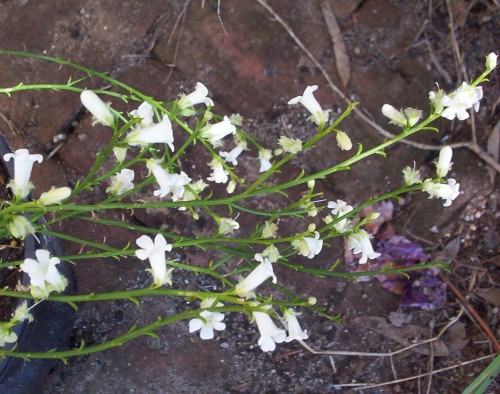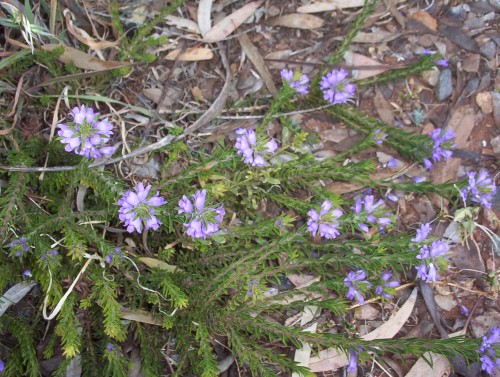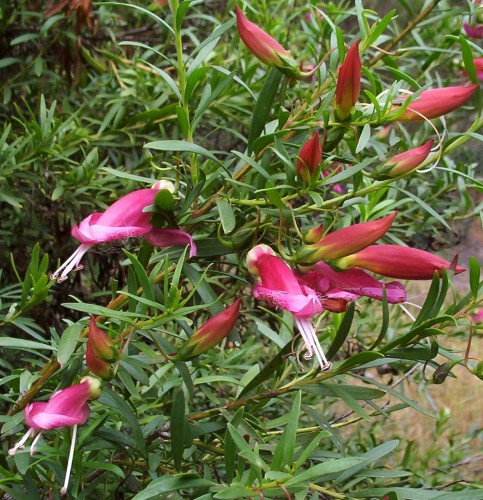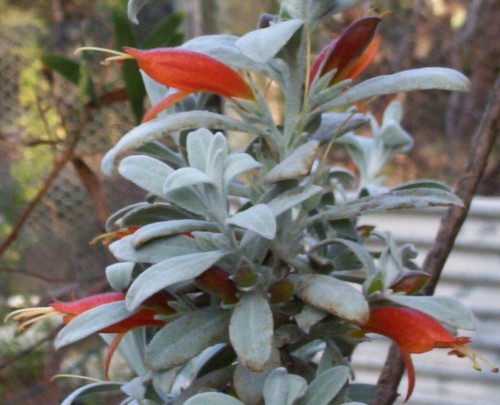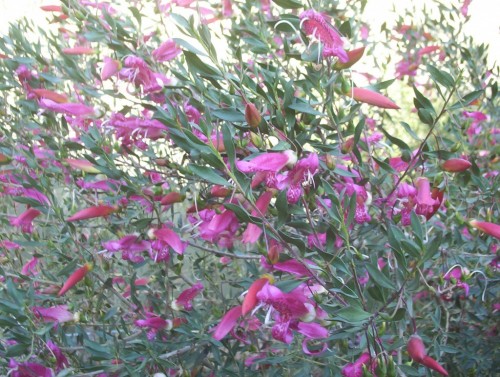Eremophila dempsteri
This shrub is a little like ‘broom bush’ and grows between 1-4 metres tall. It originates from Western Australia in the area of Balladonia and Coolgardie and Salmon Gums in woodland areas. The plant rarely exceeds 1.5m on poorer soils.
I like this plant because even when the flowers have finished it maintains interest in the garden. The calyx and developing seed pods are densely hairy and, along with the flowering time, gives the appearance of flowering continuously for several months.
The flowers are usually lilac, but purple and white forms are also available.
Eremophila densifolia (prostrate form)
This is one of my favourite plants. I have been growing it for about 20 years and it has a few flowers most of the year with a main flush in spring and autumn. It is a low spreading plant. I have another form which is quite flat. Not a vigorous plant to be controlled but grows to about a metre (3 feet) wide in our poor soil. The one in the photo occasionally has branches to about 30cm (1 foot).
I have not seen any frost burn on the tips but occasionally caterpillars make webs in some branchlets and defoliate them. The colour is a deep purply blue and I have seen variations on this on other plants. It is a difficult colour to photograph.
Eremophila maculata (Spotted Emu Bush)
I have had this pretty dark pink form growing for 20 years in a windbreak/screen. I established it by watering with drippers as it was growing in amongst existing Eucalyptus (mallee trees). Over the years I have taken numerous cuttings from the bush and trimmed where webbing caterpillars had defoliated small branches. At flowering it gives a fabulous display and seems to have some flowers for most of the year with the major flowering in spring and autumn.
In our terrible soil the plant is about 1.7m high and wide. Our rainfall is about 3oomm. The current drought situation does not seem to affect the plant given that there is little moisture in the subsoil.
Eremophila glabra variety tomentosa (Emu Bush)
This is one of my favourite Eremophilas. The leaves are grey green and are softly furry which can be seen closeup to the plant (hence the variety name ‘tomentosa’). A microscope would give an even more dramatic view. With the bright red flowers for contrast it is a great bird attracting plant.
This is a plant for a dry position and well drained soil. It is about one and a half metres tall by about half a metre wide. It needs to be pruned after flowering to promote more new growth which of course produces more flowers.
There are a number of Eremophilas which come into the category of ‘glabra’, and a few others which have grey or whitish foliage with green, yellow, orange/red flowers.
Eremophila maculata forms (Emu Bush)
The Eremophila Study Group News Letter arrived and we are being encouraged to spread the good word about Eremophilas as hardy plants.
Plant hardiness is a relative term, I think. On the gardening programme Gardening Australia on ABC TV, the term is used by presenters in the Eastern States. A plant is described as hardy there, when I know that it is not hardy here unless it is regularly watered during the summer. A writer in the ‘Journal’, magazine of the Australian Plants Society, South Australia, prefers to refer to plants as being ‘adaptable’ or not. I tend to agree with him. There are many plants which would come into that category.
However, Eremophilas tend to be both hardy and adaptable. The issue that bothers many plants is over watering. Especially plants in pots. Watering regularly on a weekly basis as our water restrictions impose on us will spell disaster for many native plants, especially those that have a form of summer dormancy. Another issue is drainage which must be very good for Eremophilas.
The photo above is a selection of Eremophila maculata ‘Wendy’ which has reddish buds which open to dark pink. Tip pruning and trimming produces a bushy plant and many flowers.
